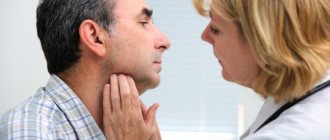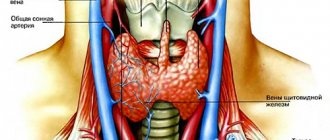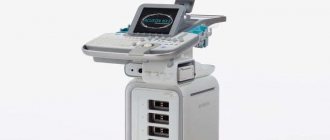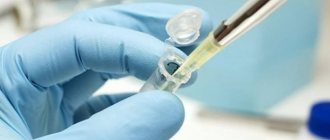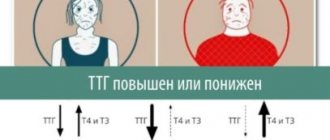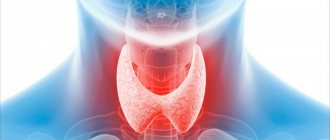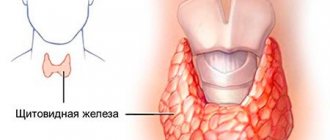It
is known that thyroid diseases are very common in the Chelyabinsk region.
The most common problem faced by our fellow countrymen is thyroid nodules. What to do if a nodule is found in the thyroid gland, which means the conclusion of THIRADS and Bethesda, our interlocutor, candidate of medical sciences, specialist in endocrine surgery, oncologist surgeon, doctor of the highest category, Sergey Anatolyevich Lukyanov, will tell you today.
— Sergey Anatolyevich, what is a thyroid nodule and why is it dangerous?
- Nodes are various formations that are found in the thyroid gland. Most thyroid nodules do not cause any symptoms. However, if they grow quickly enough, they can cause swelling in the neck and lead to difficulty breathing, swallowing, and pain. Some nodes produce excess amounts of thyroxine, the main thyroid hormone. When this occurs, symptoms of the disease are similar to those of hyperthyroidism and may include: rapid pulse, nervousness, increased appetite, tremors, weight loss, sweating.-
How common are thyroid nodules and how common is cancer?
- Nodules in the thyroid gland are very common. I will list a few basic facts about knots that will be useful for our readers to know:
• Thyroid nodules are three times more common in women than in men.
• 30% of 30 year old women will have a thyroid nodule.
• Every 40th young person most likely also has a thyroid nodule.
• Some thyroid nodules are actually cysts that are filled with fluid rather than thyroid tissue.
• Purely cystic thyroid nodules (thyroid cysts) are almost always benign.
• The prevalence of thyroid nodules increases with age: 50% of 50-year-old women will have at least one thyroid nodule. 60% of 60-year-old women will have one thyroid nodule. 70% of 70-year-old women will have at least one thyroid nodule.
• The main good news is that more than 95% of all thyroid nodules are benign (not cancerous).
— How are thyroid nodules detected?
— Some nodes are visible on the neck and can be felt by the person. However, about 50% of people have knots that are too small to feel. Usually, nodes are detected by chance - during medical examinations and in examination rooms. Most often, nodes are detected during ultrasound performed for other diseases (for example, during ultrasound of the vessels of the neck).
— Is it possible to understand from an ultrasound whether the node is dangerous or cancerous?
— Recently, the quality of ultrasound has increased significantly, and doctors have even encountered an “epidemic” of thyroid nodules. The main diagnostic task of the doctor is to assess the malignancy of the neoplasm, while the size of the node is not a determining factor. Thyroid cancer can be suspected only on the basis of a node biopsy/puncture (FNA). It is not advisable to carry out mass TAB of nodular formations, since these nodules are very common. In this regard, there was a need to create a new ultrasound classification of thyroid nodules, which could help the doctor choose surgical tactics - observation or puncture of the node. And such a classification was created, it is called THIRADS or TI-RADS.
Most specialized clinics have already switched to this system, and therefore, in the conclusion of the ultrasound protocol, we increasingly see one of the following categories:
• THIRADS 1 – normal thyroid gland
• THIRADS 2 – benign changes in the thyroid gland.
• THIRADS 3 – probably benign changes in the thyroid gland.
• THIRADS 4 – suspicious for malignant changes in the thyroid gland. This group is classified into 4a and 4b depending on the increased risk of malignancy.
— If an ultrasound revealed a THIRADS 4 node, does that mean we need to operate?
- No, it’s not necessary, since ultrasound is not a diagnosis yet. The THIRADS classification only helps the endocrinologist surgeon decide from which node the puncture should be taken. The different categories according to THIRADS are just risks. For example, with THIRADS 2, the risk of cancer is less than 5%, THIRADS 3, the risk increases to 10%, and with THIRADS 4, the risk of node malignancy is already about 15%.
- Then when should you operate?
— If after puncture of this node there is a suspicion of a tumor based on the results of the cytological report (the patient can find out how to perform a puncture of the thyroid gland in my article on the website).
— How dangerous are thyroid tumors?
— The most common types of thyroid tumors are colloid nodes and cysts; they are harmless and do not require surgical treatment. Less commonly detected are follicular tumors - neoplasms that need to be removed. Even less common is cancer, in which case the oncologist surgeon removes the affected lobe or the entire thyroid gland. To understand before surgery how dangerous a nodule is, endocrinology surgeons currently use the Bethesda cytology system.
- What is this, the Bethesda system?
— In accordance with clinical recommendations, doctors need to use 6 standard categories of cytological reports of the modern international Bethesda classification:
• Category I – uninformative puncture (done when there is insufficient material or the presence of only a cystic and colloid component), in some cases it requires repeated puncture of the node.
• Category II – benign formation (colloid and adenomatous nodes, chronic autoimmune thyroiditis, subacute thyroiditis), most often there is no need to remove such a node.
• Category III – atypia of uncertain significance (difficult to interpret
• puncture with suspected tumor lesion), it is necessary to repeat the puncture after 2-3 months.
• Category IV – follicular neoplasia or suspected follicular neoplasia. It is advisable to remove such a node.
• Category V and VI – suspected malignant or malignant tumor (suspicious papillary cancer, medullary cancer, metastatic carcinoma or lymphoma). With this conclusion, surgery is necessary.
—
What is the long-term prognosis for people with thyroid cancer?
— Patients diagnosed with cancer in the early stages of the disease generally respond well to treatment, and relapses are extremely rare (five-year survival rate is almost 97 percent). Some types of thyroid cancer have a higher recurrence rate.
— Where in the Chelyabinsk region can a thyroid puncture be performed in order to recognize a tumor as early as possible?
— Very often, the patient requires not only a puncture, but also a consultation with an endocrinologist surgeon to determine further tactics, draw up a treatment and observation plan, and, if necessary, referral for hospitalization.
An endocrinologist surgeon provides consultations in the CITYMED network of expert clinics.
Briefly about the disease
A nodule is an area that is different in density or color on ultrasound (ultrasound) from the rest of the thyroid tissue and has clear boundaries.
For a long time, the presence of nodes does not affect the functions of the gland. However, an increase in the size of the nodes leads to compression of tissues, deformation of organs appears, which can be accompanied by discomfort and unpleasant sensations.
Research shows that these formations are the most common lesion of the thyroid gland, they occur in 30-50% of the world's inhabitants, and in older people their presence in humans is almost the norm. Nodes are more common in women over 60 years of age: the likelihood of their occurrence is 6-8 times higher than in men.
There are 2 main types of nodes: benign and malignant. In our region, benign nodes are found in 95% of cases, and the remaining 5% are represented by malignant tumors. According to the morphological picture, benign nodes are colloid nodes, follicular adenomas, cysts and inflammatory processes of the thyroid gland. They can actively produce hormones or remain non-toxic for many years. The picture of the disease largely depends on the patient’s lifestyle, his state of health and other factors.
How often should I check for these nodules?
If you have any complaints (fatigue, drowsiness, weight loss, rapid or slow heartbeat, impaired hair growth, discomfort in the neck) and have close relatives with thyroid cancer, you have had episodes of radiation exposure in your life head or neck, if your age at the time of the Chernobyl nuclear power plant accident was from 0 to 18 years, then you should consult a doctor and do an ultrasound of the thyroid gland
. And even if, during the research, “something was discovered and they told you about it in a scary voice,” please do not panic, but wait for a consultation with an endocrinologist who will prescribe further tests.
When self-examining the thyroid gland, the minimum list of tests, in addition to ultrasound, includes hormonal testing
(TSH, free T4, AT-TPO) and general blood test.
Causes of nodules in the thyroid gland
- lack of iodine in the diet;
- the effects of ionizing radiation on the body;
- toxic poisoning;
- burdened heredity.
The incidence of nodules is much higher in individuals who have received increased doses of radiation. The problem is also faced by employees of enterprises whose activities involve the use of toxic substances (heavy metals, fuel, varnishes, paints, etc.). The disease is aggravated by constant stress and excessive physical activity.
Treatment
If diffuse nodular nontoxic goiter syndrome occurs without complications, the patient is prescribed hormonal therapy and radioactive iodine preparations. In some cases, surgical treatment is advisable. It is indicated for the development of neoplasia, pronounced external manifestations of goiter, difficulty swallowing and breathing associated with compression syndrome.
Therapy is aimed primarily at restoring the hormone-producing function of the thyroid gland. Treatment with radioactive iodine preparations for diffuse nodular goiter usually demonstrates good results. Radical removal of the organ through surgery and subsequent hormone replacement therapy are indicated only in the absence of results from the prescribed drug treatment.
The likelihood of malignancy of the process with diffuse nodular goiter is low. The prognosis is generally favorable. If changes in the structure of the thyroid gland were noticed at the early stage of diffuse nodular goiter and are not severe, the main role is given to conservative treatment. The doctor selects medications with iodine compounds that are actively absorbed by the human body. In most cases, this measure is sufficient to eliminate the negative symptoms of diffuse nodular goiter and gradually reduce the thyroid gland down to its normal size.
Symptoms of the development of cysts and thyroid nodules
It is almost impossible to diagnose the disease on your own. The nodes develop for a long time without showing themselves in any way. Patients do not feel any changes at all and continue to lead their usual lifestyle. The seals are painless and small in size. They are found during routine examinations or during examinations associated with other abnormalities. Up to a certain point, a person does not experience any pressure or discomfort, and there are no malfunctions in the functioning of the organ.
It is possible to detect the problem during palpation, since the nodes are easily palpable. The formations are perceived as smooth, round formations. They are dense and elastic, but still differ from healthy tissue. A dangerous symptom is the simultaneous enlargement of the lymph nodes, which may indicate malignant degeneration of the cells.
The reason for contacting a specialist is often a visual enlargement of the gland. Patients notice deformities in the neck area and make an appointment with an endocrinologist. Visible changes indicate the impressive size of the node. At this stage, the formations reach a diameter of 3 cm or more.
Typical complaints are:
- feeling of a “lump in the throat”;
- problems with swallowing;
- sore throat;
- pain in the neck and head;
- labored breathing;
- change in voice or complete loss of voice,
- appearance of cough;
- elevated temperature.
Discomfort occurs when anatomical structures close to the organ are compressed. If the autonomous thyroid nodules actively produce hormones, hyperthyroidism develops. In this case, subjective symptoms such as tachycardia, hot flashes, increased excitability or emotional lability are clearly manifested. The clinical picture is accompanied by sensations of palpitations, exophthalmos (bulging eyes), irritation, and aggression.
During the examination, much attention is paid to single nodes. Solitary formations are often malignant. When identifying such pathologies, doctors strive to conduct the most complete diagnosis. The seals are characterized by rapid growth, hard consistency, and are accompanied by changes in the lymphatic system. Numerous nodes develop into a diffuse goiter. Unfortunately, it is impossible to assess the benignity of the pathology or make an accurate prognosis based only on symptoms and external signs.
Thyroiditis
Fungus
Thyrotoxicosis
7177 02 February
IMPORTANT!
The information in this section cannot be used for self-diagnosis and self-treatment.
In case of pain or other exacerbation of the disease, diagnostic tests should be prescribed only by the attending physician. To make a diagnosis and properly prescribe treatment, you should contact your doctor. Thyroiditis: causes, symptoms, diagnosis and treatment methods.
Thyroiditis is a group of diseases of the thyroid gland, different in cause, but united by one common feature - inflammation of the gland tissue. This article will not describe autoimmune thyroiditis.
Causes of thyroiditis
The causes of thyroiditis can be different. According to the literature, there is a connection between the development of the disease and previous bacterial, fungal, and viral infections of the ENT organs (otitis, sinusitis, tonsillitis), pneumonia; thyroiditis has been described in patients with HIV, as well as after organ transplantation and chemotherapy.
In adults, the disease can be caused by staphylococci, streptococci, salmonella, brucella, klebsiella, Pseudomonas aeruginosa, Escherichia coli, etc. In children, the disease is more often associated with α- and β-hemolytic streptococci and a variety of anaerobic bacteria.
The infection enters the thyroid gland through the bloodstream, through the lymphatic tract, or as a result of injury, injury, or medical procedures. As a result, acute thyroiditis develops.
Viruses (Coxsackievirus, adenoviruses, mumps virus, measles, ECHO viruses, influenza viruses and Epstein-Barr virus) are also considered as a cause of inflammation in the thyroid gland. Penetrating inside the cell, viruses trigger the synthesis of atypical proteins, to which the body reacts with an inflammatory response. Subacute thyroiditis develops.
The incidence of viral thyroiditis increases in the autumn-winter period during the epidemic rise of viral diseases.
De Quervain's thyroiditis is one of the most common forms of subacute thyroiditis. Its cause is considered to be a viral infection, but the specific pathogen has not been identified. Typically, thyroiditis develops 5–6 weeks after acute respiratory viral infection, mumps, or infectious mononucleosis. Women get sick 4 times more often than men.
Riedel's thyroiditis is a rare form of chronic thyroiditis, characterized by extensive fibrosis, in addition to the thyroid gland, affecting the structures surrounding it. The cause of the disease is unknown. There is an assumption that Riedel's thyroiditis may be a manifestation of systemic fibrosis associated with the production of immunoglobulin of the IgG4 subclass.
The literature also describes cases of thyroiditis of fungal (pathogens - Candida, Aspergillus, Pneumocystis, Histoplasma), parasitic (Echinococcosis, Cysticercosis), tuberculous and syphilitic origin, occurring against the background of the underlying disease.
In childhood, a common cause of thyroiditis is the presence of a communication (fistula) of the thyroid lobe with the piriform sinus.
Thyroiditis can occur while taking lithium, an iodine-containing radiocontrast agent. Radiation-induced thyroiditis is known after use of I131.
As a result of taking certain medications (interferons, interleukins, monoclonal antibodies for the treatment of cancer, viral and autoimmune diseases), drug-induced thyroiditis can occur.
Classification of the disease
- Acute thyroiditis:
- purulent;
- non-purulent.
- Subacute thyroiditis:
- diffuse;
- focal.
- Chronic thyroiditis:
- autoimmune (Hashimoto's thyroiditis, lymphocytic thyroiditis of children and adolescents, postpartum thyroiditis, etc.);
- Riedel's fibrous thyroiditis (Riedel's goiter) with the absence of compression syndrome or with the presence of compression syndrome;
- medicinal;
- specific thyroiditis (tuberculous, syphilitic, septicomycosis).
Symptoms of thyroiditis
Acute thyroiditis, caused by a bacterial infection, begins with fever, headache, severe pain and discomfort in the thyroid gland. The causes of pain are swelling of the thyroid gland and stretching of its capsule. Upon examination, a tumor-like formation is determined on the anterior surface of the neck, redness of the skin.
The addition of a purulent process is manifested by a further increase in temperature to 39-40°C. Pain in the neck when turning the head or when swallowing may spread to the jaw, ear and/or shoulder on the affected side. With purulent inflammation of tissues with their melting and the formation of a purulent cavity (abscess), softening of the tissues is determined. The cervical lymph nodes are enlarged and painful.
Subacute thyroiditis against the background of a viral disease occurs as a typical inflammatory disease: against the background of malaise, low-grade fever, general weakness, moderate or severe pain appears in the thyroid gland, often radiating to the ears, jaw or throat. Sometimes there is pain when swallowing and turning the head. The thyroid gland is usually somewhat enlarged, painful on palpation, fibrosis of the gland (overgrowth of connective tissue) is manifested by an increase in its density. If not the entire gland is affected, but a section of it, then they speak of focal subacute thyroiditis, which is determined to the touch as a painful lump.
Riedel's thyroiditis is characterized by diffuse enlargement of the thyroid gland with the replacement of its parenchyma by fibrous tissue and the formation of a dense goiter. The process involves not only the gland itself, but also the surrounding anatomical structures: trachea, esophagus, vessels, nerves, muscles. Riedel's thyroiditis is often combined with fibrosis of other localizations (retroperitoneal, mediastinal, pulmonary, orbital). The disease develops slowly; initially, patients note the appearance of a tumor-like formation on the anterior surface of the neck of rocky density. Subsequently, there is a swallowing disorder associated with involvement of the esophagus in the process; voice changes (hoarseness); shortness of breath due to damage to the trachea; secondary exophthalmos with damage to the muscles of the eyeball and retrobulbar tissues; stridor breathing (wheezing, noisy breathing caused by turbulent air flow passing through a narrowed area of the upper respiratory tract) with damage to the recurrent laryngeal nerve; venous sinus thrombosis due to involvement of the vasculature.
Diagnosis of thyroiditis
When diagnosing acute thyroiditis, it is necessary to exclude the following diseases: subacute thyroiditis, neck phlegmon, anaplastic carcinoma, acute hemorrhage into a thyroid cyst, adenoma, infection of the deep tissues of the neck, pharyngitis, esophagitis, otitis media, periodontal or gingival abscess.
In addition, it is necessary to exclude the initial form of diffuse toxic goiter, autoimmune thyroiditis, and carcinoma.
Chronic Riedel's thyroiditis is differentiated (distinguished) from thyroid cancer.
In the diagnosis of thyroiditis, in addition to the examination, during which signs of inflammation of the thyroid gland are identified, data from additional laboratory and instrumental studies are used.
Laboratory diagnosis of thyroiditis includes:
- clinical blood test: determination of hemoglobin concentration, number of erythrocytes, leukocytes and platelets, hematocrit and erythrocyte indices (MCV, RDW, MCH, MCHC), leukoformula and ESR (with microscopy of a blood smear in the presence of pathological changes);
Basic methods for diagnosing thyroid nodules and cysts
Each patient who consults an endocrinologist regarding thyroid formations goes through a series of medical tests necessary to make the correct diagnosis. This:
- Examination:
presence of nervousness, fussiness of the patient; - Survey:
data on the possibility of exposure to radiation during life, on concomitant diseases, on diseases in relatives; - Palpation of the thyroid gland
: in this case, nodes can be detected in 3-7% of people who do not have any symptoms; - Ultrasound:
a mandatory examination for thyroid diseases. The sensitivity of ultrasound significantly increases the possibilities of palpation (which most often only allows one to suspect the presence of pathology) and detects nodes up to 1 cm in size; - Fine needle aspiration biopsy (FNA):
considered the main diagnostic method in the evaluation of patients with thyroid nodules; - Blood test for hormone levels:
TSH (thyroid-stimulating hormone), free T3 (triiodothyronine), free T4 (thyroxine); - Determination of the titer of antibodies to thyroid tissue:
AT to TPO (antibodies to thyroid peroxidase); - Scintigraphy:
the method is based on the use of iodine isotopes that accumulate in the tissues of the thyroid gland.
Identification of the problem of compression of nearby organs is carried out using bronchoscopy or laryngoscopy. Additional research methods are also widely used. Doctors have a wide range of radiological techniques in their arsenal.
Diagnosis and treatment of diffuse nodular goiter of the thyroid gland in Moscow
The danger of diffuse nodular goiter is that in the early stages it practically does not manifest itself externally. Symptoms become apparent only after changes in thyroid hormone levels and significant enlargement of the thyroid gland. The later diffuse nodular goiter is diagnosed, the more radical methods of therapy may be needed.
"Alpha Health Center" recommends checking the condition of the thyroid gland, and if necessary, undergoing treatment in a modern medical center.
For more information or to make an appointment, please contact the front desk. Share:
Treatment of benign thyroid nodules
- hormone therapy,
- surgical treatment,
- minimally invasive procedures.
Minimally invasive procedures
- Ethanol sclerotherapy.
For cystic thyroid nodules (the nodule is filled with fluid), the surgeon, under ultrasound control, removes fluid from the node and gradually injects 95% ethyl alcohol (ethanol) into the cyst, which causes the death of the node cells. After 4-5 sessions, the cyst in the thyroid gland can decrease by 90%. - Laser-induced thermotherapy.
Under ultrasound control, a quartz light guide is inserted into the tissue of the thyroid nodule, through which laser radiation is supplied to the node. Under the influence of light energy transmitted by the laser, the node heats up and its cells die. The dead cells are subsequently replaced by scar tissue. - Radiofrequency thermal destruction.
It is used mainly to suppress the activity of large autonomously functioning nodes that cause thyrotoxicosis. Such formations are most often found in elderly patients with severe comorbidities and contraindications to surgical treatment. The technique is as follows. A needle is inserted into the thyroid node, from which conductors equipped with temperature sensors are extended into the tissue of the node. Using a radio frequency generator, a high-frequency electromagnetic field is created on the conductors, which heats the tissue of the node to 105 degrees, which leads to irreversible damage to the cells of the node.
Surgical treatment
As we said earlier, only after FNA of the thyroid gland and obtaining a histological report of the node tissue are the indications for surgery determined.
If histology reveals a “colloid node” (benign formation), and the patient has no complaints, surgery is not indicated for him. At the same time, there are situations in which a “colloid nodule” is also detected during FNA of the thyroid gland, but surgical treatment is recommended for these patients.
This happens in the following cases:
- When the thyroid nodule increases to a large size, and compression of the neck organs appears, accompanied by disturbances in the swallowing process or a feeling of suffocation.
- When the growth of a node leads to deformation of the anterior surface of the neck.
- If the growth of the node is accompanied by an increase in the amount of thyroid hormones and leads to the appearance of thyrotoxicosis.
The extent of surgical intervention depends on the degree of damage to the thyroid gland. This may be the removal of one lobe - hemithyroidectomy in the presence of a single node, or removal of the entire gland - thyroidectomy in the case of multiple nodes.
If FNA followed by histological findings definitely confirms the malignant nature of the nodule (papillary carcinoma, follicular carcinoma, medullary carcinoma, squamous cell carcinoma, anaplastic thyroid carcinoma), the only correct solution would be to remove the thyroid gland completely.
Which nodes are dangerous?
Medical studies have proven that benign formations in the thyroid gland do not pose any danger to the patient. They do not transform into cancerous tumors and, under good circumstances, do not require any surgical or drug treatment. Only if there are complaints from the patient, surgical intervention is performed, which involves correcting the size of the thyroid gland.
If a malignant nodule is found in the thyroid gland, then the danger here is obvious. Timely diagnosis and prompt treatment make it possible to get rid of the disease without any complications. Modern algorithms for fighting cancer effectively act on the tumor without harming the general condition of the body.
If the presence of even a small benign node causes serious concern to the patient, then there is a need to remove it to alleviate the health condition.
Etiology of the disease
The causes of nodular goiter have not been fully studied by official medicine. They vary depending on the histological picture. Thus, toxic goiter develops as a result of a mutation in the thyroid-stimulating hormone receptor gene and G protein, which normally inhibits the production of adenylate cyclase. The altered protein uncontrollably stimulates this enzyme, which leads to increased cell proliferation. Mutations are also responsible for the development of medullary cancer.
The occurrence of colloid goiter is associated with age-related changes in the organ. A predisposing factor to the development of this disease is a lack of iodine in the body. Lack of a microelement also causes thyrotoxic multinodular goiter. We should not forget about predisposing hereditary factors, genomic pathologies, negative environmental influences (ionizing radiation), side effects from taking certain medications, smoking, lack of vitamins and minerals, psycho-emotional stress, chronic infectious and inflammatory diseases (for example, chronic tonsillitis) . All of the above factors can serve as a trigger for the development of nodular pathology of the thyroid gland.
Symptoms of the disease
Often, provided that the thyroid gland is of normal size and its function is optimal, patients do not report any complaints. Clinical manifestations make themselves felt only if excessive enlargement of the organ leads to compression of the surrounding anatomical structures, as well as in case of dysfunction of the gland itself.
Mechanical compression of nearby organs causes various complaints depending on which organ is affected. Thus, compression of the larynx and trachea leads to breathing problems, foreign body sensation, a constant dry cough and a hoarse voice. Compression of the esophagus makes swallowing difficult. Compression of blood vessels is fraught with the appearance of general cerebral symptoms, as well as difficulty in the outflow of venous blood from the upper parts of the body. Pain may also be observed at the location of the thyroid gland due to the development of an inflammatory process in it or a rapid increase in the size of the pathological focus.
Violation of the functional activity of the organ leads to the appearance of hyper- or hypothyroidism. Hyperfunction is manifested by characteristic symptoms of thyrotoxicosis: prolonged low-grade fever, trembling at the fingertips, increased heart rate, protruding eyeballs, increased irritability, insomnia, pronounced appetite, accompanied by weight loss.
Reduced thyroid function or hypothyroidism is manifested by clinical symptoms opposite to thyrotoxicosis: decreased body temperature, bradycardia, drowsiness, and lack of appetite. Patients are concerned about dry skin, pain in the cardiac region, a decrease in blood pressure, a depressive state develops, disorders of the gastrointestinal tract, genital area, patients often become susceptible to diseases of the upper respiratory tract and acute respiratory viral infections.
Disease prognosis
The prognosis of the disease depends on the morphological picture after the biopsy. For example, nodular euthyroid colloid goiter has the most positive prognostic indicators, while thyroid cancer cannot boast of this.
It is necessary to contact an endocrinologist on time, at the very first signs of the disease. It is better to carry out screening examinations so as not to miss the initial stages of thyroid disease, when there is still the possibility of a complete cure.
CELT doctors are always happy to help: establish a diagnosis, determine the causes of the disease and correctly prescribe the necessary treatment for the identified pathology, taking into account the individual characteristics of your body. If indicated, the clinic also performs operations to remove thyroid tumors. CELT specialists have a huge amount of knowledge and practical skills behind them, so you can safely entrust your health to our highly qualified professionals.
Make an appointment through the application or by calling +7 +7 We work every day:
- Monday—Friday: 8.00—20.00
- Saturday: 8.00–18.00
- Sunday is a day off
The nearest metro and MCC stations to the clinic:
- Highway of Enthusiasts or Perovo
- Partisan
- Enthusiast Highway
Driving directions
